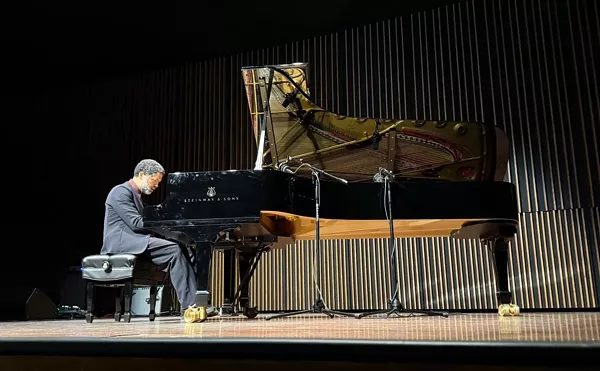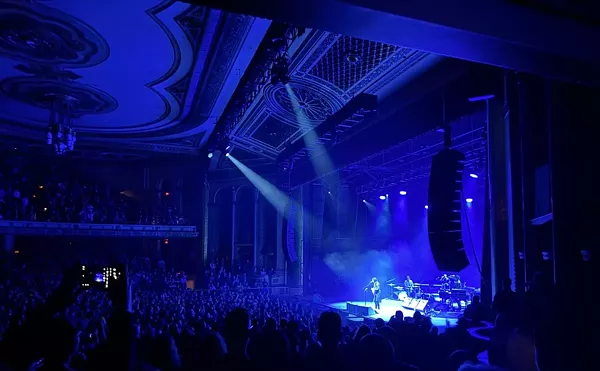
Audio By Carbonatix
[
{
"name": "GPT - Leaderboard - Inline - Content",
"component": "35519556",
"insertPoint": "5th",
"startingPoint": "3",
"requiredCountToDisplay": "3",
"maxInsertions": 100,
"adList": [
{
"adPreset": "LeaderboardInline"
}
]
}
]
Inside a rehearsal room at the Max M. Fisher Music Center, 17-year-old baritone saxophonist Tony Lustig kicks off a jam session with a handful of students from the Civic Jazz Orchestra and the Civic Jazz Band. They play Thelonious Monk’s “Rhythm-a-ning.” Rehearsal doesn’t officially begin until 6 p.m., but as usual the kids are 30 minutes early.
These young musicians like to warm up early, and the session sounds good. Some parents in the room agree. Lustig’s mother sways as if she’s at a jazz show. The father of alto sax-player Victoria Williams hums along with the melody. Normally, the parents wait in the lobby.
On the second chorus of “Rhythm-a-ning,” their teacher, bassist Rodney Whitaker, walks into the room. He greets the parents. Then he gradually transforms the impromptu session into a concert-like performance. He does this without squelching student enthusiasm.
“Tony, try playing the tune a littler slower. Yeah! That’s how you do it. You sound really good,” Whitaker says. He then explains the basic ideas of accompaniment, how not to step on what Lustig is playing.
The Civic Jazz Orchestra and the Civic Jazz Band are part of the Detroit Symphony Civic Ensembles — an offshoot of the Civic Orchestra, which started 30 years ago under the umbrella of the Detroit Symphony Orchestra. There are two sister ensembles, the Civic Sinfonia and the Civic Philharmonia. Both, like the CJO, were established in 1999. The CJB is brand-new. All told, the ensembles have more than 400 student musicians.
The CJO is an advanced set, and CJB is a preparatory group for students not quite ready to play in an orchestral setting. The basic idea is student training and development. It’s also about enriching the lives of both students and parents.
See, the 18 students in the CJO and the 16 in the CJB plan to be the next generation of jazz innovators. They’re mostly teenagers — their ages run from 7 to 21 — who are passionate about the music.
For example, 14-year-old Alex Sloboda digs drummer Elvin Jones. And Victoria Williams has been a Charlie Parker fan since the fifth grade.
Williams, who is a freshman at the Detroit High School for the Fine and Performing Arts, studies with saxophonists George Benson and Larry Nozero. “I like jazz more than other forms of music because of the freedom. I get really excited when I play it,” she says.
Tony Lannen is a 12-year-old bass player. He’s a shy kid until he starts thumping his bass. That’s when the confidence surfaces. He says bassists Paul Chambers and Charles Mingus are his faves.
The program’s music director, Charles Burke, came on board in 2003. Burke has extensive orchestral experience and has taught at the University of Michigan. He loves the possibilities of what the students can achieve.
“The thing about having the Civic Jazz Orchestra and the Civic Jazz Band here at the Max is it provides a different level of experience and expectation for the students,” Burke says. “When Rodney steps in front of the students, they know that he is the best. He’s under the umbrella of a world-class orchestra.”
Applicants must audition to join either group. This year, they had to perform trumpeter Thad Jones’ catchy “The Groove Merchant.” The participating students either are recruited or apply. Tuition is minimal, and primary funding comes from Ford Motor Co., Target Corp. and private donations.
Once accepted, students are mentored by college music students and working jazz musicians. September-to-June rehearsal schedules are rigorous.
“They have to be thirsty for the knowledge that we have to offer them,” Burke says. “And so we take all those things into consideration. That’s why when a student has an audition, not only do we want them to play for us, we also want them to engage in a conversation with us. I want to know where they go to school. I want to know if they play in their church. I want to engage them in a conversation.”
Regardless of their age or social or ethnic backgrounds, the students are encouraged and expected to excel. It’s apparent tonight that the kids aren’t afraid of high expectations.
“I think that sometimes we underestimate young people,” Burke continues. “You expect the greatest from them, and they will produce the greatest. We really have ordinary kids doing extraordinary things.”
The students will perform the music of Duke Ellington and Count Basie on Nov. 17. It will be their debut, and it’ll be a huge undertaking. Can they handle it?
The grooming sessions
Whitaker challenges and channels the students’ talents. He’s also a Civic Orchestra alumnus. He is proof of the curriculum’s success and brings considerable experience to the table.
For six years, the bassist played with the Lincoln Center Jazz Orchestra and doubled briefly as its educational consultant. As a sideman, he has performed on roughly 115 albums, and he has made five albums as a leader. Whitaker is also director of jazz studies at Michigan State University.
“A lot of the things that I’m doing here with the Civic Jazz I learned at the Lincoln Center,” Whitaker says.
It’s obvious that Whitaker is a patient teacher, and the students respond in kind. They all appear to be professional and receptive with a level of maturity one might expect from seasoned musicians. What’s more, there’s a sense that the kids are picking up on not just the mechanics of the music, but also its soul, feel and heart.
“We learn how to play off our senses,” says bassist Noah Jackson, a junior at Southfield-Lathrup High. “A lot of times when you play classical music it’s not something that you feel, or can connect with. Through the program I have been able to evolve.”
The Detroit jazz community has been supportive as well.
Tenor saxophonist DeSean Jones is a junior at the High School for the Fine and Performing Arts. He began playing four years ago. This year he snagged a spot on stage with the Gerald Wilson Orchestra at the Ford Detroit International Jazz Festival, and has jammed with sax greats Donald Walden and James Carter. Jones says he’s gained much from the support of both the community and the program.
“I noticed that there is a lot of excitement and enthusiasm amongst everybody here who loves this music,” he says. “I think everybody in this program loves jazz music. We talk a lot about being on time, knowing your music and putting the time and dedication into the music. I’ve seen a lot of attention to detail.”
Parents are participating too. They get a chance to watch their kids grow musically and socially.
“The educational program they have here and what they have been able to give these kids is far beyond comprehension,” Gina Lustig says. “To see the kids start at one spot and to see how they have grown by the end of the season is amazing,”
The students don’t plan to stop playing after they leave the program. Most say they want to play jazz professionally.
“Music is my life, period,” Jones says. “It’s what I eat, sleep and breathe. Music is what I’m going to do when I get older, and it’s probably what I’m going to have my kids doing.”
The Detroit Symphony Civic Jazz Orchestra performs Wednesday, Nov. 17, at the Music Box inside the Max M. Fisher Music Center (3711 Woodward, Detroit; 313-576-5111). Showtime is 7 p.m.
Charles L. Latimer writes about jazz for Metro Times. Send comments to letters@metrotimes.com




